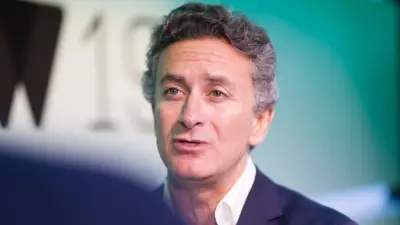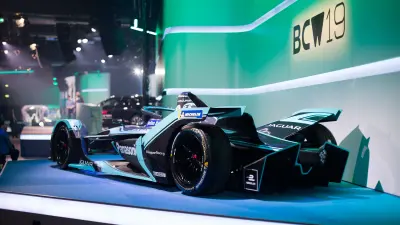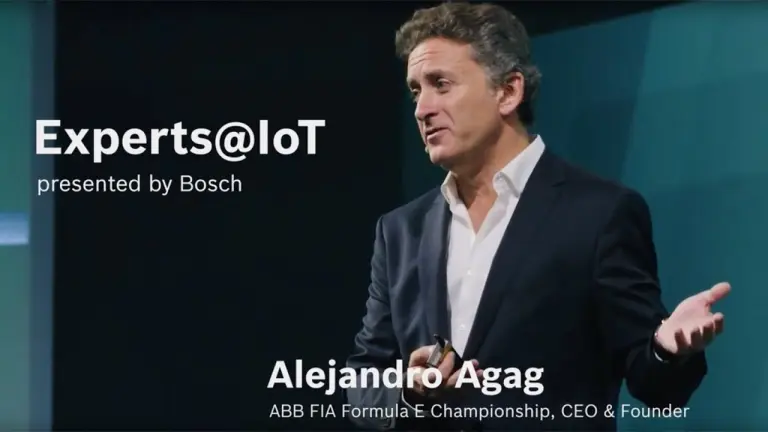Formula E — mobility laboratory of the future
In dialogue with the chairman of Formula E

2019-11-07
You don’t need a time machine to take a peek at the future of mobility. As the chairman of Formula E, Alejandro Agag, sees it, the world of tomorrow is already here — in the form of the Formula E motorsport series.
“The ABB FIA Formula E Championship is a laboratory of technology for electric cars, it’s a platform where big brands and racing teams can develop technology to win the race and then to use that technology on road cars,” says Alejandro Agag. The Spanish businessman has been in charge of Formula E since 2012; it was finally launched as an all-electric racing series in 2014. During this time, Agag managed to intensify the transfer of racing and series technology and simultaneously combine technology with emotional impact. “You need to excite the fans, you need to attract them with something real, with a real sport and a real fight.” The next major aim is to get closer to the series’ “big brother,” Formula 1.

Although this presents a big challenge, Agag has the spirit of the age on his side, as electromobility has really started to take off. The number of electric vehicles globally grew in the course of 2018 by 64 percent, to more than 5.6 million. “Car brands are modifying their production lines to adjust to e-mobility. The world is changing in a way that reflects our own direction.”
More than 300 million
viewers followed at least one Formula E race during the 2018 season.
On average during 2018, 27.1 million people watched each Formula E race, marking a significant increase of 18.6 million viewers as compared to the previous year. The motorsport series Formula E, dubbed the “future of motorsport technology” by ESPN, is becoming a showcase that attracts big car firms. Audi, BMW, Jaguar, Mercedes, Nissan, Porsche, and Renault are all on board. Manufacturers expect to see an important stimulus for future series models, if not more. “Formula E can really show in very concrete examples how technologies are evolving, showcasing ultrafast charging, improving the software that is the key part of the energy on the powertrain of electric cars. There are many different ways where Formula E can push forward the technology of these electric vehicles,” believes Agag. “Formula E will be the most relevant championship in terms of transfer of technology.”

Just one battery per Formula E race
A large hurdle was overcome with the development of a single battery that can power a race car for an entire race. Prior to 2018, the entire car had to be swapped during a race.
“I think that is the big success of Formula E, to continue to be a laboratory in terms of the development of technology in order to showcase to the public that electric cars are going longer and are going faster every year.”
Alternatives to lithium-ion batteries in sight
The electric racing series founder does not see the current solution provided by lithium-ion batteries as the be all and end all. “We are looking into every alternative for the future. We have a license to race any kind of energy source or energy storage that powers an electric motor.
That can be hydrogen, that can be supercapacitors, that can be batteries.” Agag still holds that batteries are the only practical solution that we currently have, even if their chemical composition may well change. He is still keeping alternatives in mind.
The urban DNA of the Formula E motorsport series
There are no alternatives, however, when it comes to the second key component of Formula E’s DNA (beyond the electric drive): “We race inside the cities. We are the only championship in the world, that does races inside the cities.” The reason for this is simple. “We want to take the show closer to the people, to where the people live.”
For Agag, it’s important to showcase electric vehicles in an environment where the road version is most likely to be used, and that is in the city. This is made possible because of local zero-emission motoring and because the electric race cars stick within noise limits. For Agag, this is possibly the most important unique selling point compared to Formula 1: “That’s why Formula E is completely unique, it’s the city street championship.”
An interview with Alejandro Agag, Chairman of Formula E

Loading the video requires your consent. If you agree by clicking on the Play icon, the video will load and data will be transmitted to Google as well as information will be accessed and stored by Google on your device. Google may be able to link these data or information with existing data.
Profile

Alejandro Agag, 49
Chairman of Formula E Holdings
Main purpose of the Formula E? More electric cars on the streets.
The Spanish businessman Alejandro Agag studied business in Madrid, Spain, and was an advisor to the Prime Minister of Spain, José María Aznar. He has also held positions including the Deputy Secretary General of the European People’s Party. He made the transition from politics to business in 2003. In 2008, he was named “Businessman of the Year” by GQ magazine. In 2012, he founded the Formula E Holdings and acted as its CEO before becoming its chairman in 2019.
Summary
For Alejandro Agag, the future of mobility is electric — which is why he sees Formula E as the future, too. For him, the electric racing series is like a laboratory in which the world of tomorrow is already on display. He sees various options for the engine of the future — hydrogen, supercapacitors, batteries.



